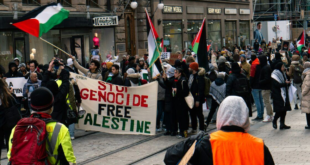 Iranian artists, painters show works at Madrid’s respected ARCO arts fair, attract international interest. As debuts go it was small, but one that pulled no punches as Iranian artists showed off works for the first time this week at Madrid’s respected ARCO arts fair. Â
Iranian artists, painters show works at Madrid’s respected ARCO arts fair, attract international interest. As debuts go it was small, but one that pulled no punches as Iranian artists showed off works for the first time this week at Madrid’s respected ARCO arts fair. Â
A trio of artists and painters standing on opposite sides of the traditional and avant-garde divide provided oeuvres which tackled topics ranging from the 1980-88 conflict with Iraq to the position of women in Iranian society.
Â
The Silk Road Gallery, hosted the works by artists Shadi Ghadirian, Bahman Jalali, Malekeh Nayini, Sadegh Tirafkan, Seifollah Samadian and Khosrow Hassanzadeh at one of 22 Asian galleries ARCO is featuring this year, up from 14 last year.
Â
Fifteen were from specially invited country South Korea, while China provided another five and Israel and Iran one each.
Â
The Silk Road Gallery’s chosen half dozen are, according to the gallery, “representative of the dynamic movement in art which has emerged in Iran over the past decade.
Â
“The exuberance of their works surprises and attracts the international interest,” the gallery said.
Â
All artists subtly represent aspects of Iranian daily life, without obvious political overtones, Silk Road director Anahita Ghabaian-Ettehadieh said.
Â
“It’s not overtly political, but an indirect reflection of what is happening in the country,” explained Ghabaian-Ettehadieh, pointing to works by Bahman Jalali, protagonist of a 2003 exhibition of “Iran in the 21st Century” at London’s Brunei Gallery hosted by the School of Oriental and African Studies.
Â
Bahman Jalali, founder of Iran’s first photography museum, contributed his series of portraits entitled “Image of Imagination” showing a plethora of black-and-white images from Iranian history, including kings and eunuchs, assembled as a multi-layered collage.
Â
A red floral splash tops off each of the prints, some of which fetched thousands of euros (dollars) at Christies in Dubai earlier this year.
Â
Some of Hassanzadeh’s work meanwhile alluded to the Iran-Iraq conflict while Ghadirian, seen as the face of the Iranian avant-garde contributed a group of veiled women wearing coloured veils part hidden by a wall.
Â
“The techniques being used here are a little Warholesque,” Ghabaian-Ettehadieh says of the prints, adding that Iranian contemporary art is undergoing “constant renovation.”
Â
She points to Nayini Malakeh’s “Updating a Family Album,” showing members of a seemingly well-to-do family clad in almost garishly colourful garb superimposed on figures that appear to date from well before the Islamic Revolution.
Â
Without delving into a discussion on the potential influence of contemporary Iranian politics on the country’s art, Ghabaian-Ettehadieh lamented that international recognition for some artists often led to home collectors being priced out of the market.
Â
“The future of Iranian art therefore largely lies abroad,” Ghabaian-Ettehadieh forecast.
Â
One noted Iranian artist to make her name outside her homeland and who is not on show in Madrid is Shirin Neshat.
Â
Neshat emigrated as a teenager to the United States before the revolution and her work throws the lives of women in an Islamic society into stark relief, such as in her mid 1990s series “Women of Allah.”
Â
“She reflects the culture of her country but does not live there,” observed Ghabaian-Ettehadieh, viewing home-grown demand as the preserve of an elite and moneyed social stratum.
Â
Iran’s “contemporary art is very strong, though as yet limited. But it’s emerging, little by little,” she concluded.
 Eurasia Press & News
Eurasia Press & News

